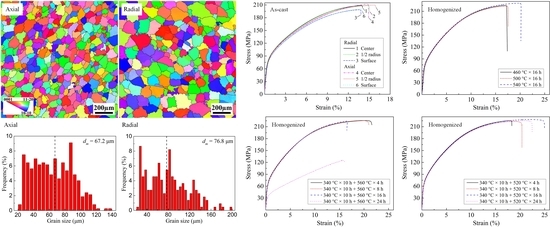Microstructure and Mechanical Properties of the As-Cast and As-Homogenized Mg-Zn-Sn-Mn-Ca Alloy Fabricated by Semicontinuous Casting
Abstract
:1. Introduction
2. Experimental Procedures
2.1. Semicontinuous Casting
2.2. Homogenization Treatment Process
2.3. Microstructure and Mechanical Properties
3. Results and Discussion
3.1. As-Cast Alloy
3.1.1. Microstructure and Texture
3.1.2. Mechanical Properties and Fracture Behaviors
3.2. As-Homogenized Alloy
3.2.1. Microstructure
3.2.2. Mechanical Properties and Fracture Behaviors
4. Conclusions
- (1)
- The average grain size and the second phase size decrease, but the area fraction of the second phase increases gradually from the center to the surface of the ingot.
- (2)
- The mechanical properties of the alloy in axial direction are slightly better than those in the radial direction, but independent on texture.
- (3)
- The sample at 1/2 radius of the ingot along the axial direction exhibits the optimum comprehensive mechanical properties due to the combined effect of relatively small grain size, low second phase fraction, and uniform microstructure.
- (4)
- In one-step homogenization, the morphology of CaMgSn and grain size has no obvious change when homogenized at 460 °C. While at 500 °C and 540 °C, the CaMgSn is dissolved gradually from long strip-like into short rod-like or chain-like with the increase of homogenization time, and the grains grow obviously when the homogenization time exceeds 16 h.
- (5)
- In two-step homogenization, the low-melting-point phase MgZn2 can be dissolved into the matrix for 10 h at low-temperature stage of 340 °C. At high-temperature stage of 520 °C, with the increase of homogenization time, the elongation of the alloy firstly increases and then decreases, while the yield strength always decreases.
- (6)
- The optimum homogenization process of ZTMX3100 alloy is 340 °C × 10 h + 520 °C × 16 h. After the optimum homogenization treatment, the proper size and morphology of CaMgSn phase are conducive to improve the microstructure uniformity and the mechanical properties of the alloy. Besides, the yield strength of the alloy is reduced by 20.7% and the elongation is increased by 56.3%.
Author Contributions
Funding
Acknowledgments
Conflicts of Interest
References
- Hofstetter, J.; Rüedi, S.; Baumgartner, I.; Kilian, H.; Mingler, B.; Povoden-Karadeniz, E.; Pogatscher, S.; Uggowitzer, P.J.; Löffler, J.F. Processing and microstructure-property relations of high-strength low-alloy (HSLA) Mg-Zn-Ca alloys. Acta Mater. 2015, 98, 423–432. [Google Scholar] [CrossRef]
- Joost, W.J.; Krajewski, P.E. Towards magnesium alloys for high-volume automotive applications. Scr. Mater. 2017, 128, 107–112. [Google Scholar] [CrossRef]
- Pollock, T.M. Weight loss with magnesium alloys. Science 2010, 328, 986–987. [Google Scholar] [CrossRef] [PubMed]
- Mirza, F.A.; Wang, K.; Bhole, S.D.; Friedman, J.; Chen, D.L.; Ni, D.R.; Xiao, B.L.; Ma, Z.Y. Strain-controlled low cycle fatigue properties of a rare-earth containing ME20 magnesium alloy. Mater. Sci. Eng. A 2016, 661, 115–125. [Google Scholar] [CrossRef]
- Fang, D.; Ma, N.; Cai, K.; Cai, X.; Chai, Y.; Peng, Q. Age hardening behaviors, mechanical and corrosion properties of deformed Mg-Mn-Sn sheets by pre-rolled treatment. Mater. Des. 2014, 54, 72–78. [Google Scholar] [CrossRef]
- Hu, G.; Xing, B.; Huang, F.; Zhong, M.; Zhang, D. Effect of Y addition on the microstructures and mechanical properties of as-aged Mg-6Zn-1Mn-4Sn (wt %) alloy. J. Alloys Compd. 2016, 689, 326–332. [Google Scholar] [CrossRef]
- Lu, X.; Zhao, G.; Zhou, J.; Zhang, C.; Chen, L.; Tang, S. Microstructure and mechanical properties of Mg-3.0Zn-1.0Sn-0.3Mn-0.3Ca alloy extruded at different temperatures. J. Alloys Compd. 2018, 732, 257–269. [Google Scholar] [CrossRef]
- Sasaki, T.T.; Ju, J.D.; Hono, K.; Shin, K.S. Heat-treatable Mg-Sn-Zn wrought alloy. Scr. Mater. 2009, 61, 80–83. [Google Scholar] [CrossRef]
- Sasaki, T.T.; Elsayed, F.R.; Nakata, T.; Ohkubo, T.; Kamado, S.; Hono, K. Strong and ductile heat-treatable Mg-Sn-Zn-Al wrought alloys. Acta Mater. 2015, 99, 176–186. [Google Scholar] [CrossRef]
- Sasaki, T.T.; Yamamoto, K.; Honma, T.; Kamado, S.; Hono, K. A high-strength Mg-Sn-Zn-Al alloy extruded at low temperature. Scr. Mater. 2008, 59, 1111–1114. [Google Scholar] [CrossRef]
- Wei, J.; Chen, J.; Yan, H.; Su, B.; Pan, X. Effects of minor Ca addition on microstructure and mechanical properties of the Mg-4.5Zn-4.5Sn-2Al-based alloy system. J. Alloys Compd. 2013, 548, 52–59. [Google Scholar] [CrossRef]
- Nayyeri, G.; Mahmudi, R. Effects of Ca additions on the microstructural stability and mechanical properties of Mg-5%Sn alloy. Mater. Des. 2011, 32, 1571–1576. [Google Scholar] [CrossRef]
- Hasani, G.H.; Mahmudi, R. Tensile properties of hot rolled Mg-3Sn-1Ca alloy sheets at elevated temperatures. Mater. Des. 2011, 32, 3736–3741. [Google Scholar] [CrossRef]
- Ali, Y.; Qiu, D.; Jiang, B.; Pan, F.; Zhang, M. Current research progress in grain refinement of cast magnesium alloys: A review article. J. Alloys Compd. 2015, 619, 639–651. [Google Scholar] [CrossRef]
- Mingo, B.; Arrabal, R.; Mohedano, M.; Mendis, C.L.; del Olmo, R.; Matykina, E.; Hort, N.; Merino, M.C.; Pardo, A. Corrosion of Mg-9Al alloy with minor alloying elements (Mn, Nd, Ca, Y and Sn). Mater. Des. 2017, 130, 48–58. [Google Scholar] [CrossRef]
- Rashkova, B.; Prantl, W.; Görgl, R.; Keckes, J.; Cohen, S.; Bamberger, M.; Dehm, G. Precipitation processes in a Mg-Zn-Sn alloy studied by TEM and SAXS. Mater. Sci. Eng. A 2008, 494, 158–165. [Google Scholar] [CrossRef]
- Wang, B.; Pan, F.; Chen, X.; Guo, W.; Mao, J. Microstructure and mechanical properties of as-extruded and as-aged Mg-Zn-Al-Sn alloys. Mater. Sci. Eng. A 2016, 656, 165–173. [Google Scholar] [CrossRef]
- Mahallawy, E.N.; Diaa, A.A.; Akdesir, M.; Palkowski, H. Effect of Zn addition on the microstructure and mechanical properties of cast, rolled and extruded Mg-6Sn-xZn alloys. Mater. Sci. Eng. A 2017, 680, 47–53. [Google Scholar] [CrossRef]
- Mendis, C.L.; Bettles, C.J.; Gibson, M.A.; Hutchinson, C.R. An enhanced age hardening response in Mg-Sn based alloys containing Zn. Mater. Sci. Eng. A 2006, 435, 163–171. [Google Scholar] [CrossRef]
- Pan, H.; Qin, G.; Xu, M.; Fu, H.; Ren, Y.; Pan, F.; Gao, Z.; Zhao, C.; Yang, Q.; She, J.; et al. Enhancing mechanical properties of Mg-Sn alloys by combining addition of Ca and Zn. Mater. Des. 2015, 83, 736–744. [Google Scholar] [CrossRef]
- Chen, J.; Chen, Z.; Yan, H.; Zhang, F. Microstructural characterization and mechanical properties of a Mg-6Zn-3Sn-2Al alloy. J. Alloys Compd. 2009, 467, L1–L7. [Google Scholar] [CrossRef]
- Du, Y.Z.; Zheng, M.Y.; Qiao, X.G.; Wu, K.; Liu, X.D.; Wang, G.J.; Lv, X.Y. Microstructure and mechanical properties of Mg-Zn-Ca-Ce alloy processed by semi-continuous casting. Mater. Sci. Eng. A 2013, 582, 134–139. [Google Scholar] [CrossRef]
- Du, Y.Z.; Zheng, M.Y.; Xu, C.; Qiao, X.G.; Wu, K.; Liu, X.D.; Wang, G.J.; Lv, X.Y. Microstructures and mechanical properties of as-cast and as-extruded Mg-4.50Zn-1.13Ca (wt%) alloys. Mater. Sci. Eng. A 2013, 576, 6–13. [Google Scholar] [CrossRef]
- Sadeghi, I.; Wells, M.A.; Esmaeili, S. Modeling homogenization behavior of Al-Si-Cu-Mg aluminum alloy. Mater. Des. 2017, 128, 241–249. [Google Scholar] [CrossRef]
- Kim, S.; Park, S.H. Influence of Ce addition and homogenization temperature on microstructural evolution and mechanical properties of extruded Mg-Sn-Al-Zn alloy. Mater. Sci. Eng. A 2016, 676, 232–240. [Google Scholar] [CrossRef]
- Miao, H.; Huang, H.; Shi, Y.; Zhang, H.; Pei, J.; Yuan, G. Effects of solution treatment before extrusion on the microstructure, mechanical properties and corrosion of Mg-Zn-Gd alloy in vitro. Corros. Sci. 2017, 122, 90–99. [Google Scholar] [CrossRef]
- Peng, Q.Z.; Zhou, H.T.; Zhong, F.H.; Ding, H.B.; Zhou, X.; Liu, R.R.; Xie, T.; Peng, Y. Effects of homogenization treatment on the microstructure and mechanical properties of Mg-8Li-3Al-Y alloy. Mater. Des. 2015, 66, 566–574. [Google Scholar] [CrossRef]
- Liu, K.; Wang, X.; Wen, K. Effect of isothermal homogenization on microstructure and mechanical properties of the Mg-5Y-4Gd-0.5Zn-0.4Zr alloy. Mater. Des. 2013, 52, 1035–1042. [Google Scholar] [CrossRef]
- Yang, M.; Liang, X.; Yi, Z.; Pan, F. Effects of zirconium addition on as-cast microstructure and mechanical properties of Mg-3Sn-2Ca magnesium alloy. Mater. Des. 2011, 32, 1967–1973. [Google Scholar] [CrossRef]
- Hort, N.; Huang, Y.; Abu Leil, T.; Maier, P.; Kainer, K.U. Microstructural investigations of the Mg-Sn-xCa system. Adv. Eng. Mater. 2006, 8, 359–364. [Google Scholar] [CrossRef]
- Liu, Y.; Yuan, G.; Lu, C.; Ding, W. Stable icosahedral phase in Mg-Zn-Gd alloy. Scr. Mater. 2006, 55, 919–922. [Google Scholar] [CrossRef]
- Hadadzadeh, A.; Mokdad, F.; Amirkhiz, B.S.; Wells, M.A.; Williams, B.W.; Chen, D.L. Bimodal grain microstructure development during hot compression of a cast-homogenized Mg-Zn-Zr alloy. Mater. Sci. Eng. A 2018, 724, 421–430. [Google Scholar] [CrossRef]
- Xu, C.; Zheng, M.Y.; Chi, Y.Q.; Chen, X.J.; Wu, K.; Wang, E.D.; Fan, G.H.; Yang, P.; Wang, G.J.; Lv, X.Y.; et al. Microstructure and mechanical properties of the Mg-Gd-Y-Zn-Zr alloy fabricated by semi-continuous casting. Mater. Sci. Eng. A 2012, 549, 128–135. [Google Scholar] [CrossRef]
- Xu, S.W.; Zheng, M.Y.; Kamado, S.; Wu, K.; Wang, G.J.; Lv, X.Y. Dynamic microstructural changes during hot extrusion and mechanical properties of a Mg-5.0Zn-0.9Y-0.16Zr (wt %) alloy. Mater. Sci. Eng. A 2011, 528, 4055–4067. [Google Scholar] [CrossRef]
- Xu, S.W.; Oh-ishi, K.; Kamado, S.; Takahashi, H.; Homma, T. Effects of different cooling rates during two casting processes on the microstructures and mechanical properties of extruded Mg-Al-Ca-Mn alloy. Mater. Sci. Eng. A 2012, 542, 71–78. [Google Scholar] [CrossRef]
- Borkar, H.; Gauvin, R.; Pekguleryuz, M. Effect of extrusion temperature on texture evolution and recrystallization in extruded Mg-1%Mn and Mg-1%Mn-1.6%Sr alloys. J. Alloys Compd. 2013, 555, 219–224. [Google Scholar] [CrossRef]
- Zhang, Y.; Wu, Y.; Peng, L.; Fu, P.; Huang, F.; Ding, W. Microstructure evolution and mechanical properties of an ultra-high strength casting Mg-15.6Gd-1.8Ag-0.4Zr alloy. J. Alloys Compd. 2014, 615, 703–711. [Google Scholar] [CrossRef]
- Chang, K.; Feng, W.; Chen, L. Effect of second-phase particle morphology on grain growth kinetics. Acta Mater. 2009, 57, 5229–5236. [Google Scholar] [CrossRef]
- Luo, X.; Cao, G.; Zhang, W.; Qiu, C.; Zhang, D. Ductility Improvement of an AZ61 Magnesium Alloy through Two-Pass Submerged Friction Stir Processing. Materials 2017, 10, 253. [Google Scholar] [CrossRef] [PubMed]
- Sun, H.; Li, C.; Fang, W. Evolution of microstructure and mechanical properties of Mg-3.0Zn-0.2Ca-0.5Y alloy by extrusion at various temperatures. J. Mater. Process. Technol. 2016, 229, 633–640. [Google Scholar] [CrossRef]
- McClelland, Z.; Li, B.; Horstemeyer, S.J.; Horstemeyer, M.F.; Oppedal, A.L. Effects of homogenization on microstructure and mechanical properties of a ZE20 Mg alloy processed by indirect extrusion. In Magnesium Technology; Springer: Cham, Switzerland, 2016; pp. 141–146. [Google Scholar]
- Cheng, W.; Bai, Y.; Wang, L.; Wang, H.; Bian, L.; Yu, H. Strengthening Effect of Extruded Mg-8Sn-2Zn-2Al Alloy: Influence of Micro and Nano-Size Mg2Sn Precipitates. Materials 2017, 10, 822. [Google Scholar] [CrossRef] [PubMed]
- Huang, X.; Chino, Y.; Yuasa, M.; Ueda, H.; Inoue, M.; Kido, F.; Matsumoto, T. Microstructure and mechanical properties of AZX912 magnesium alloy extruded at different temperatures. Mater. Sci. Eng. A 2017, 679, 162–171. [Google Scholar] [CrossRef]

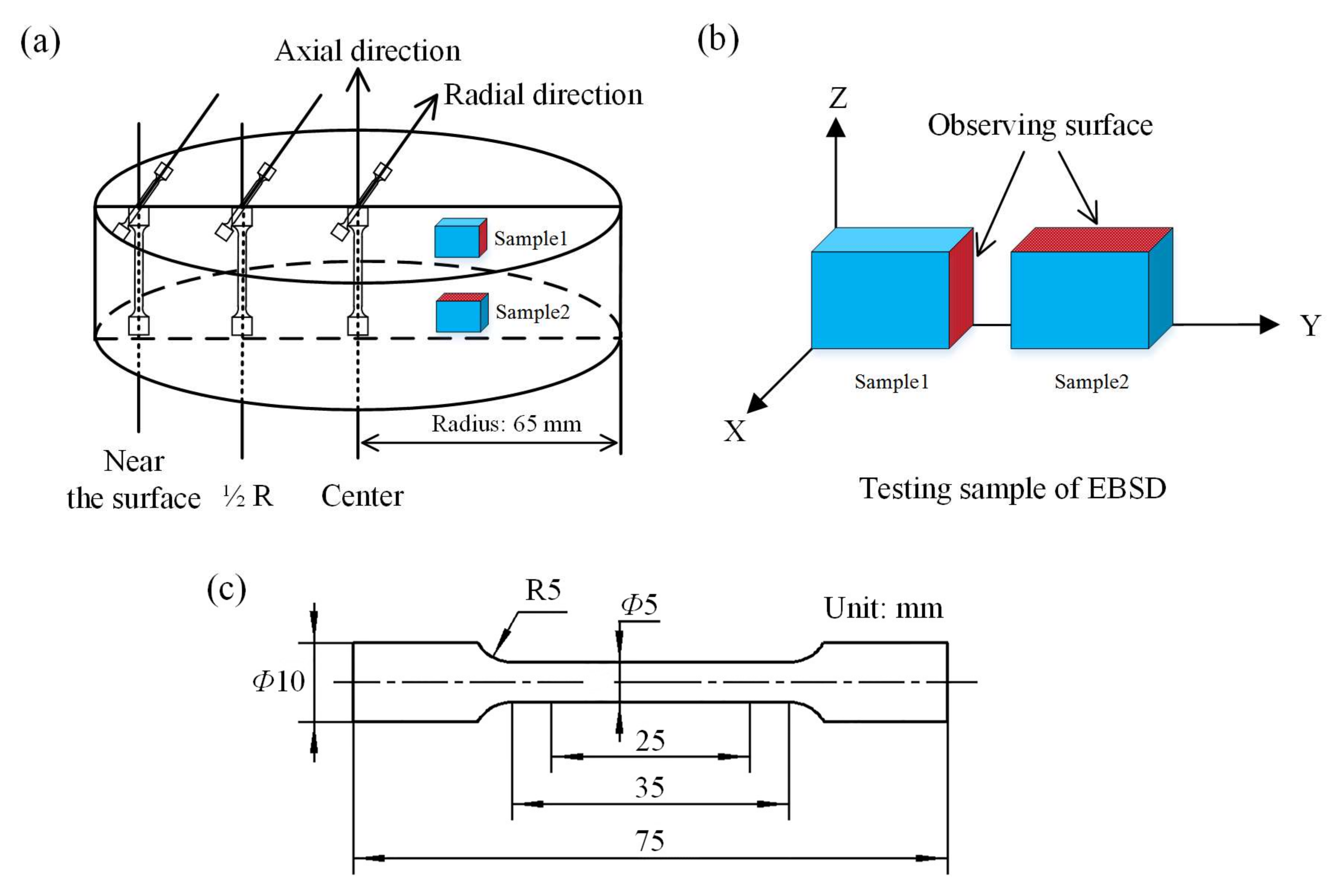
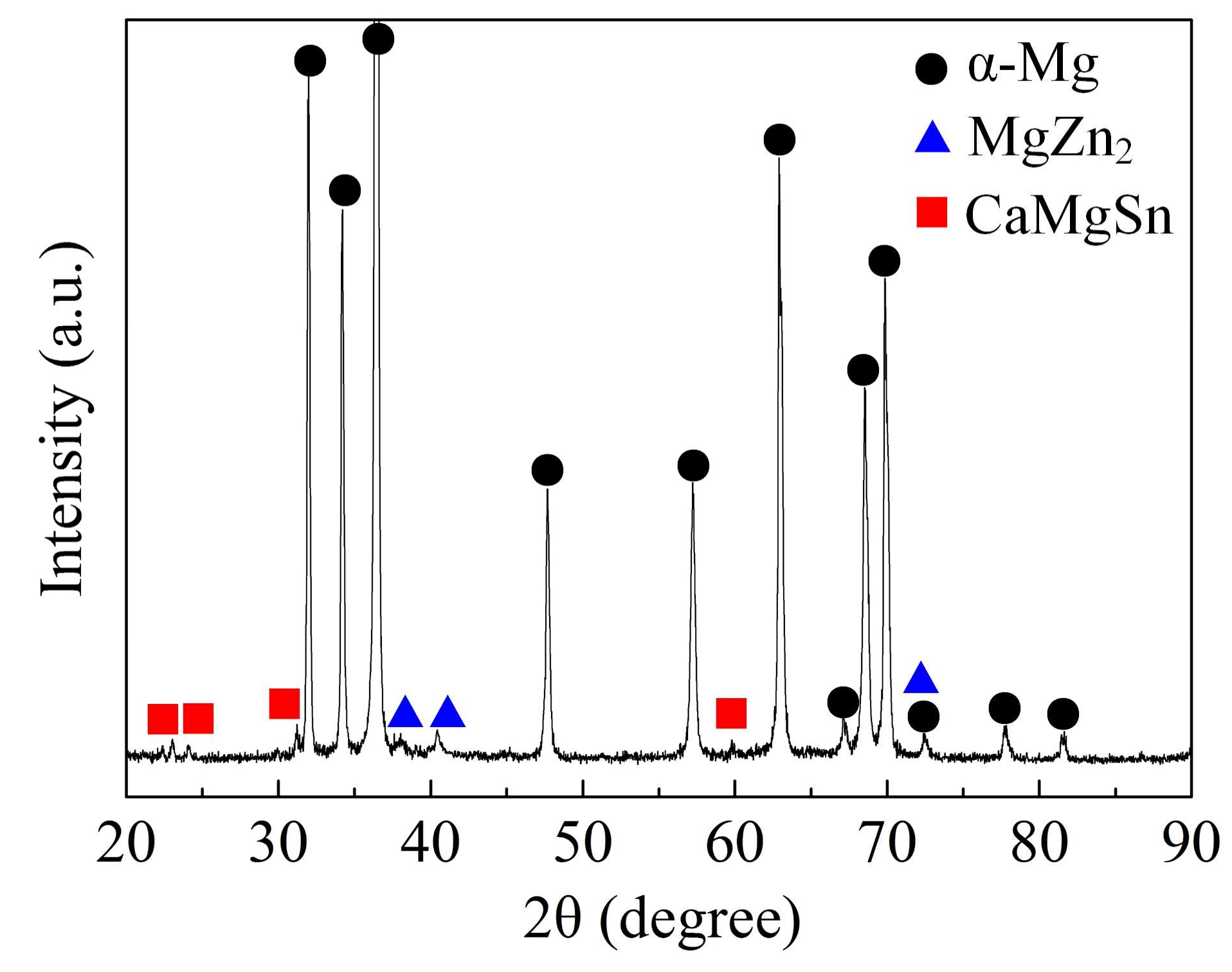
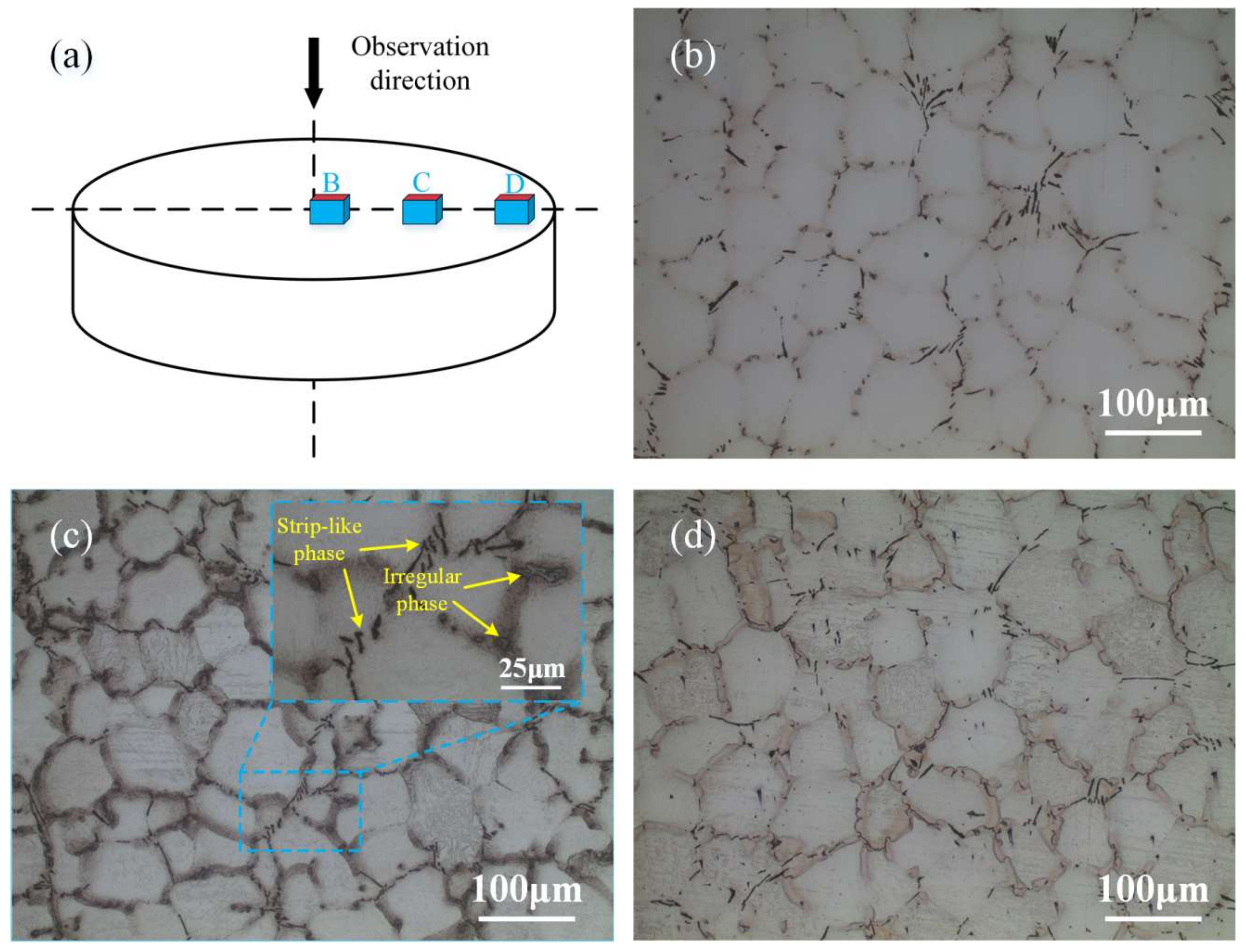

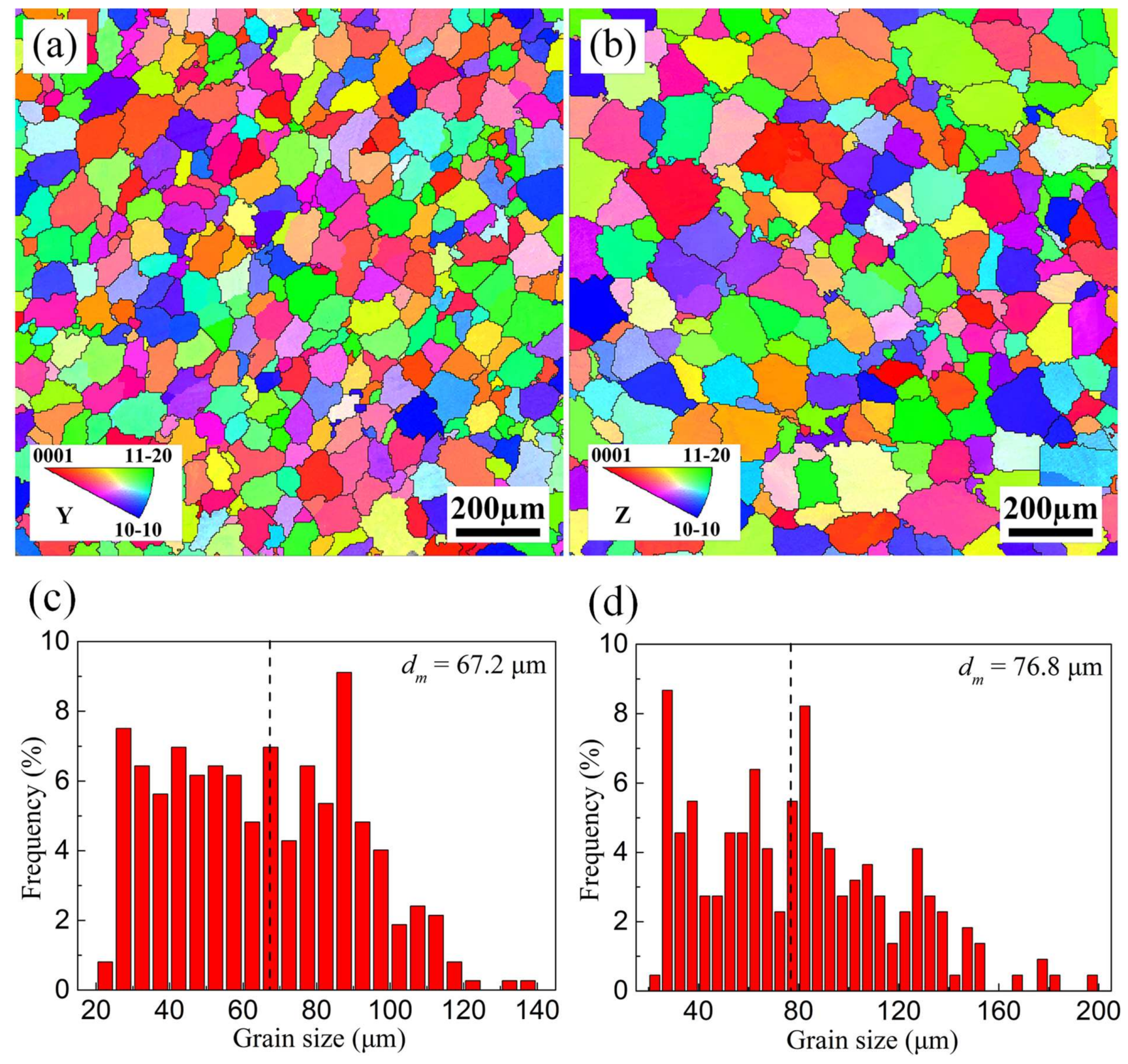

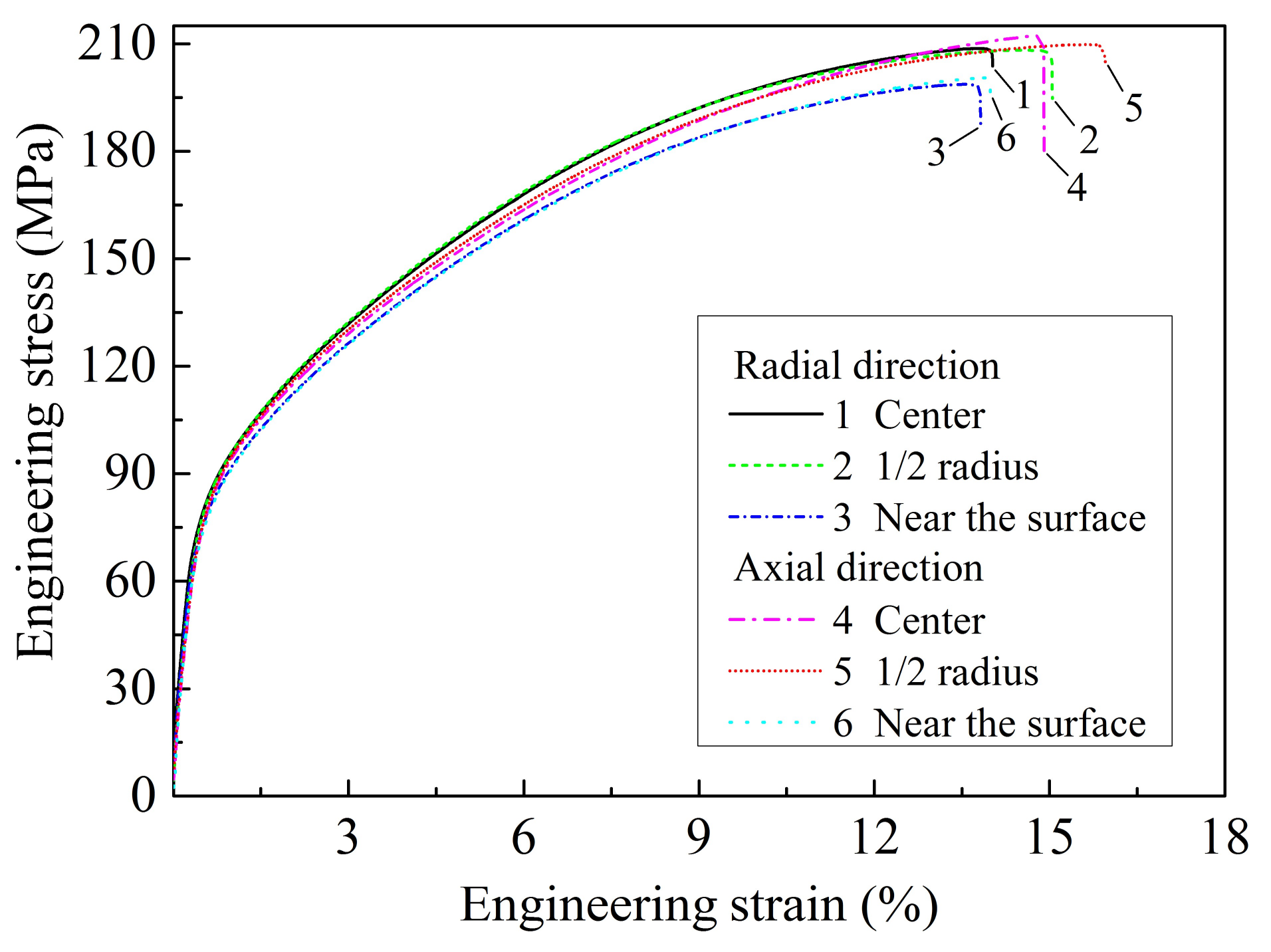
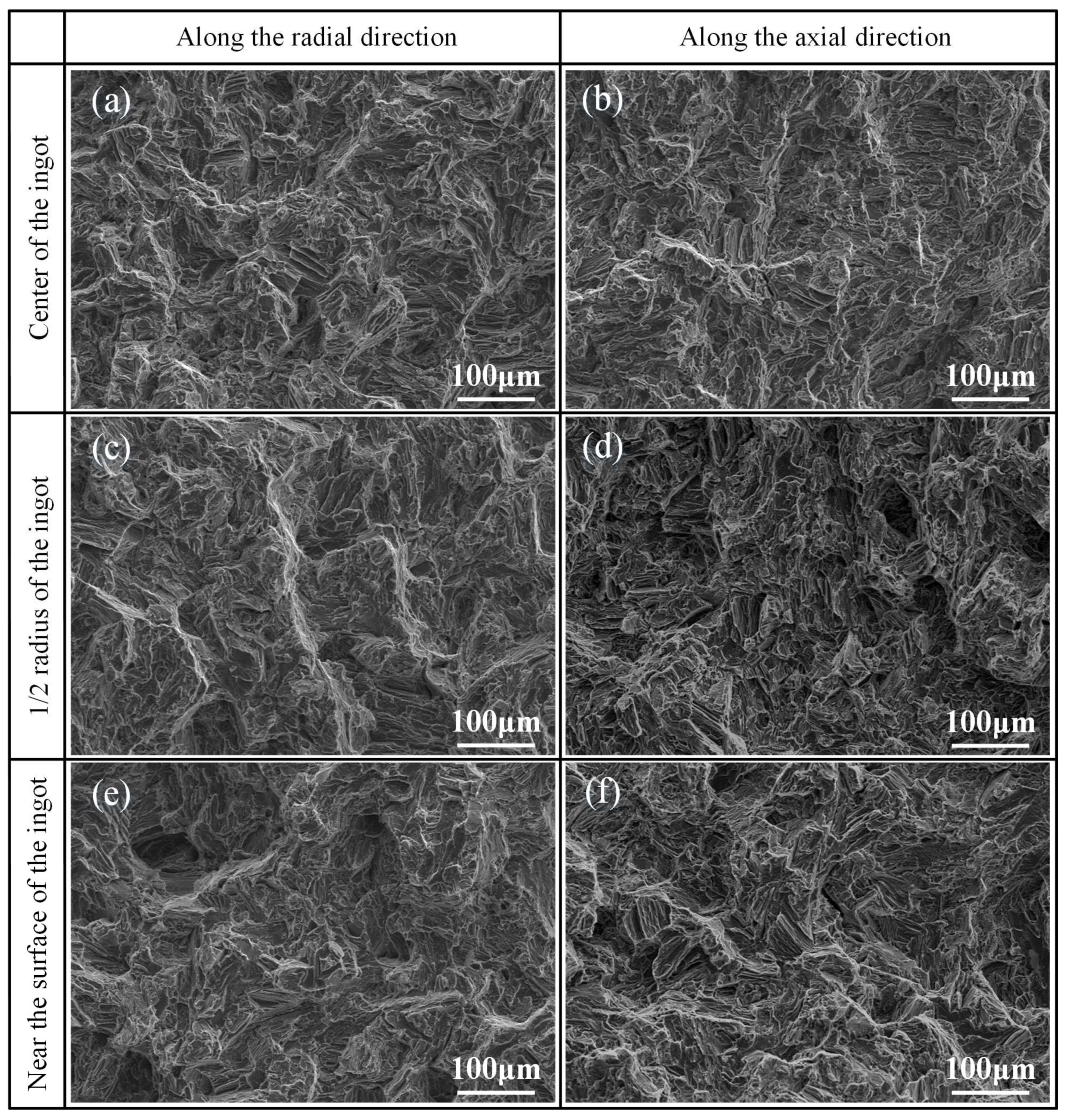
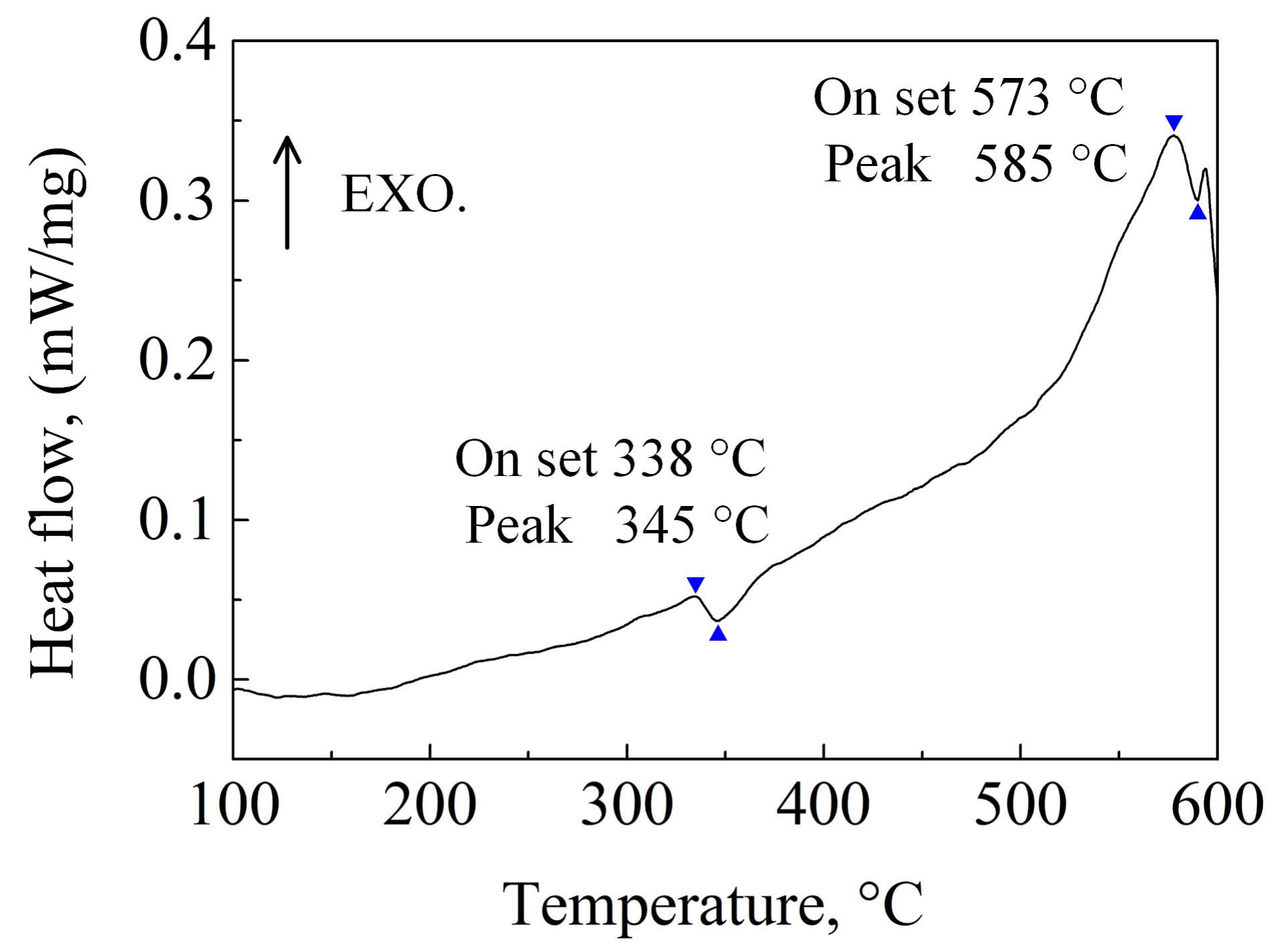
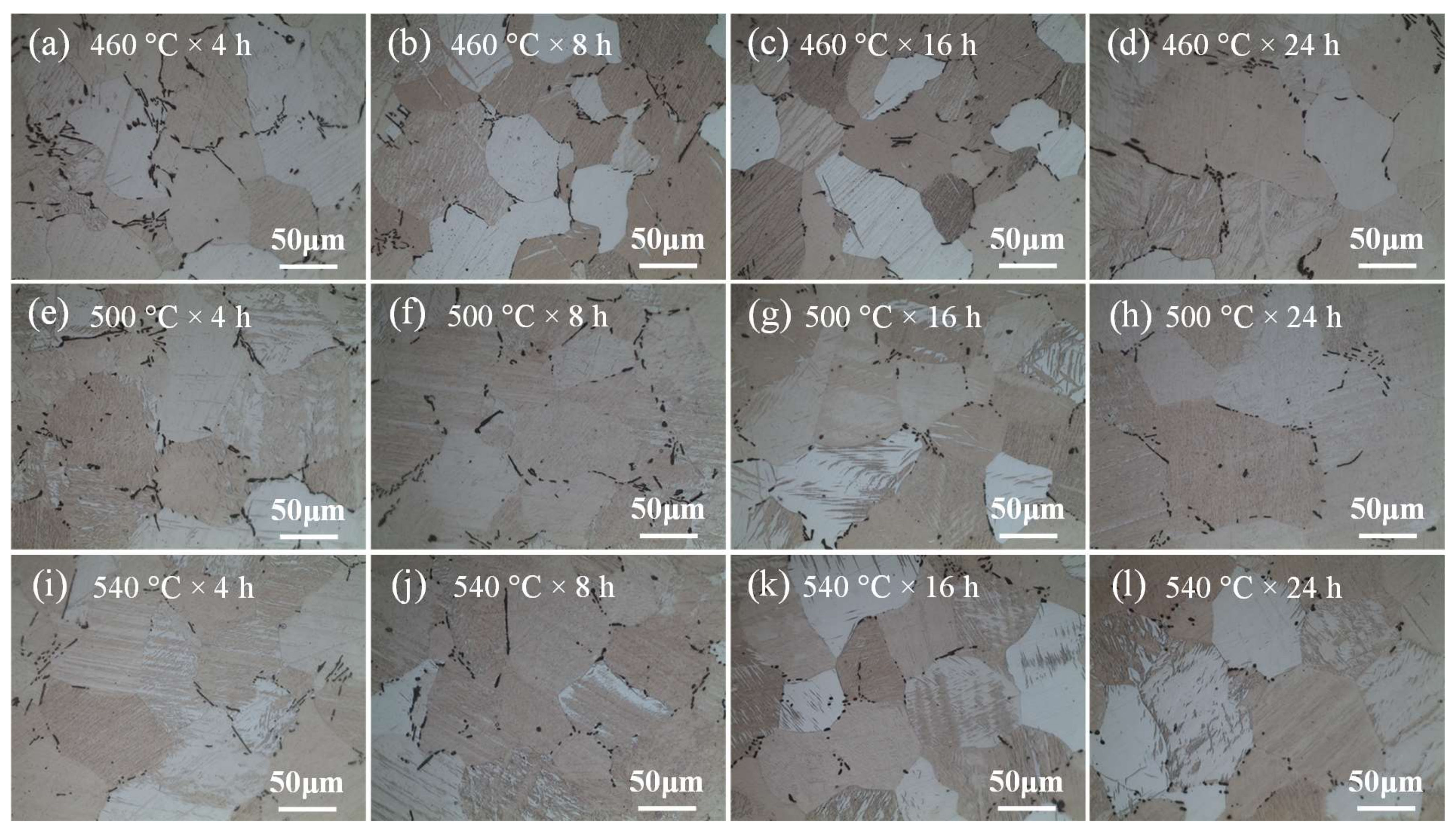
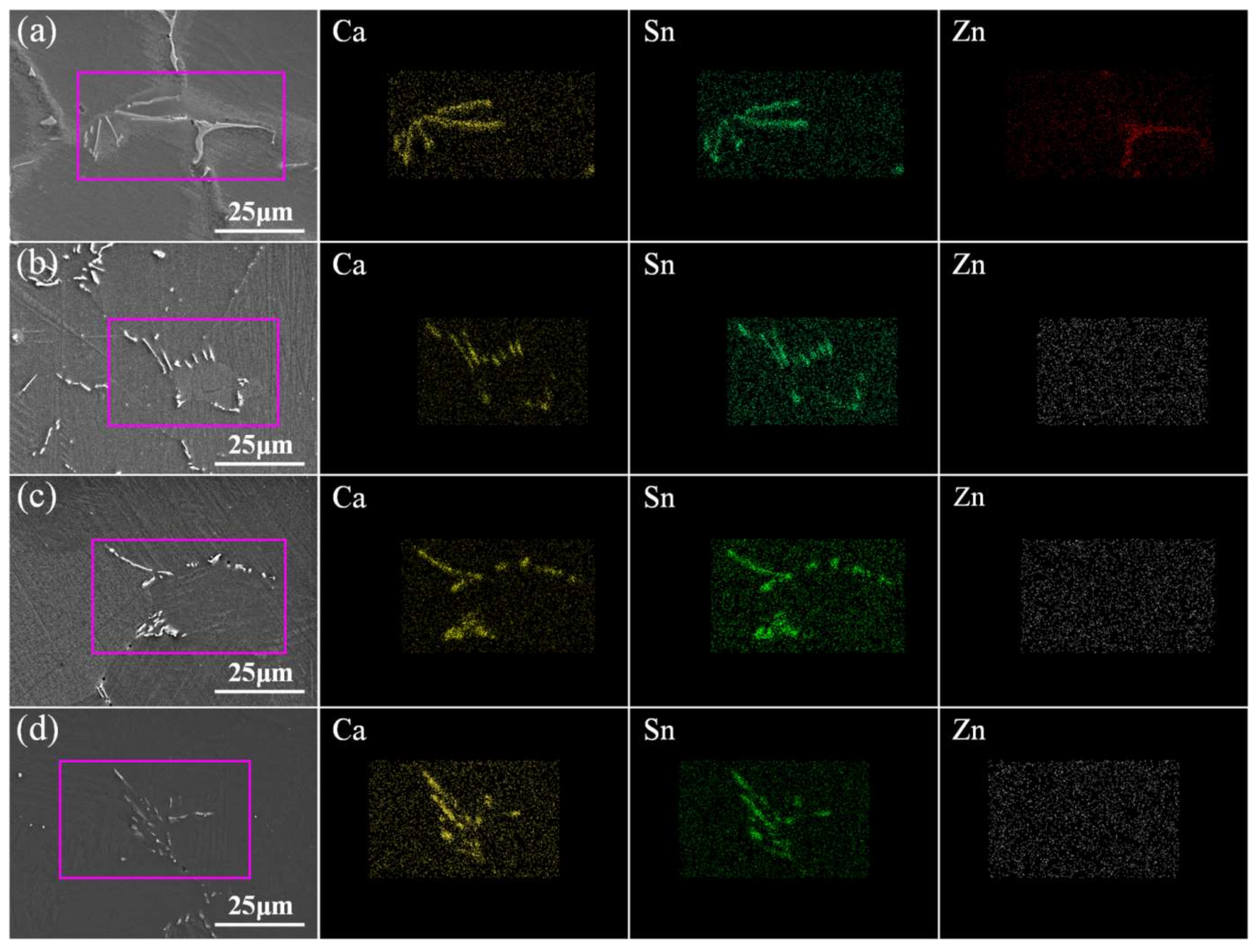

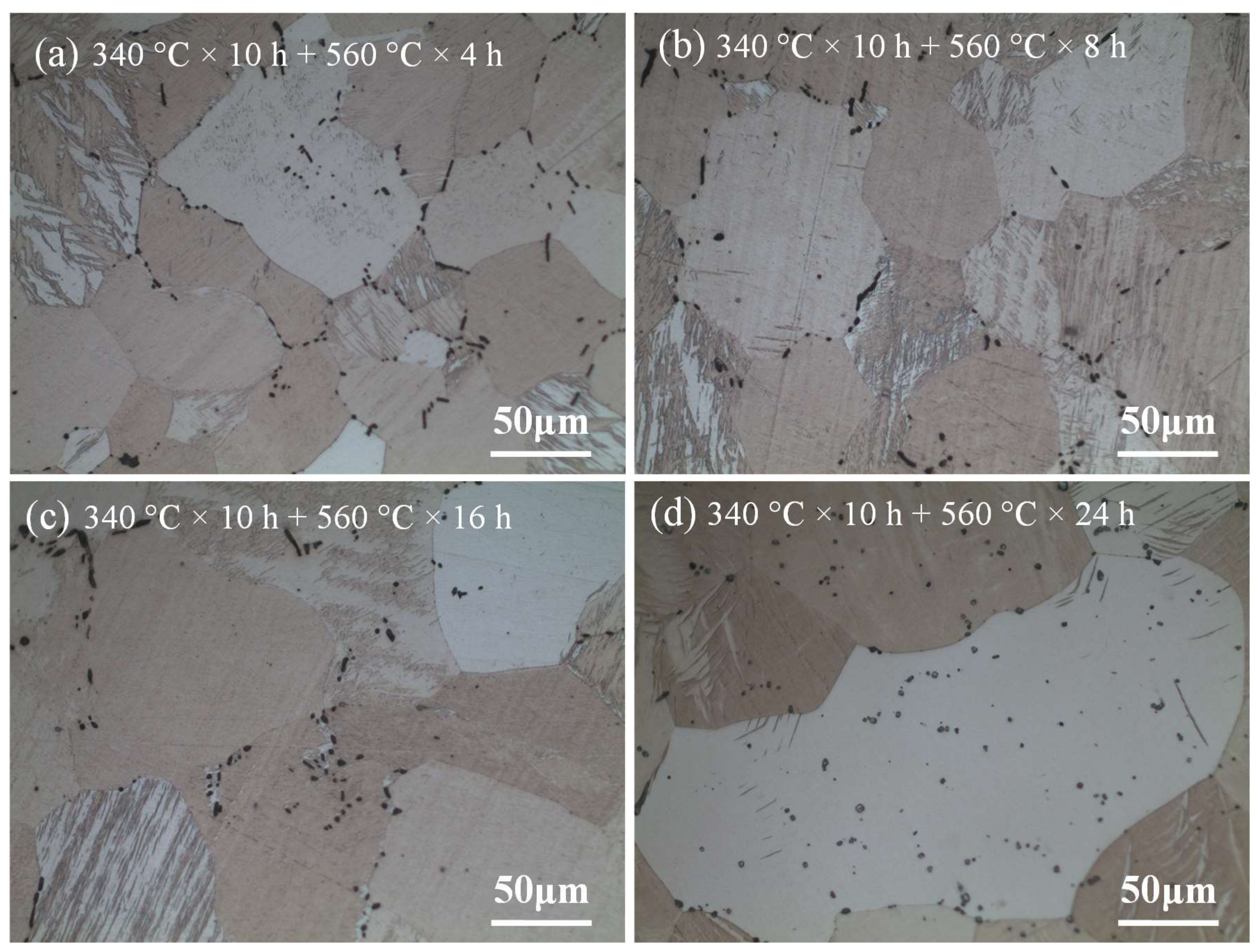
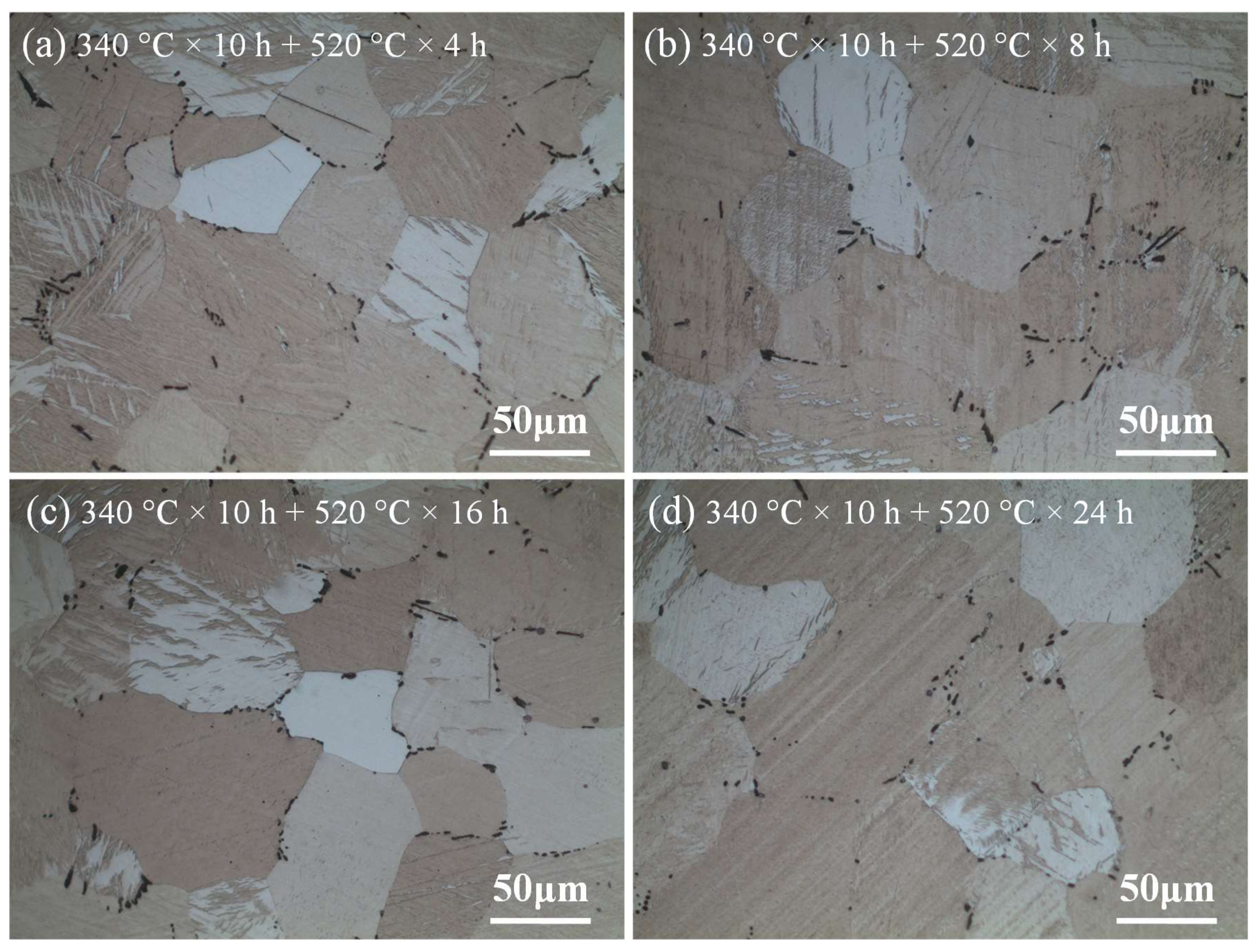
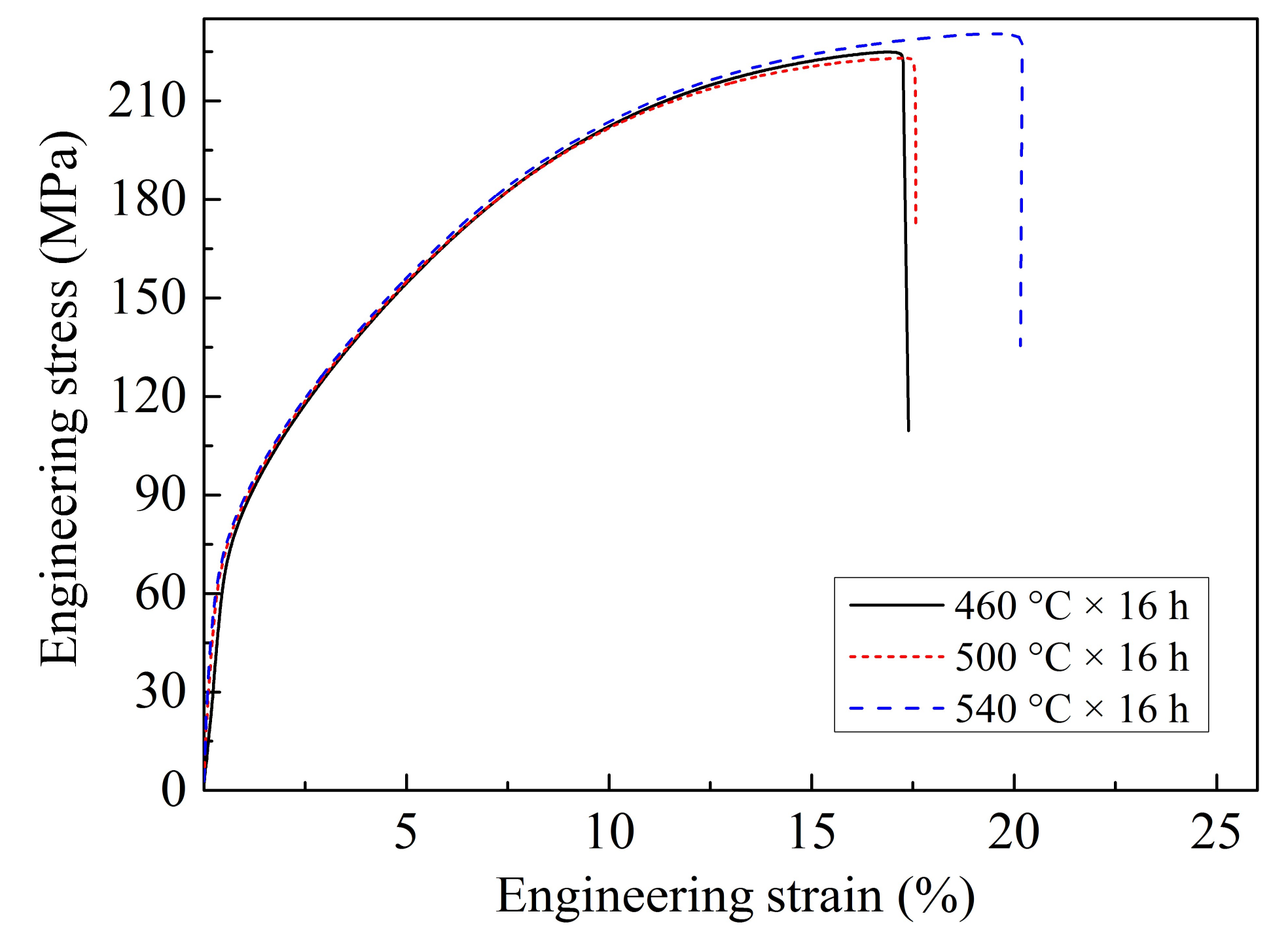
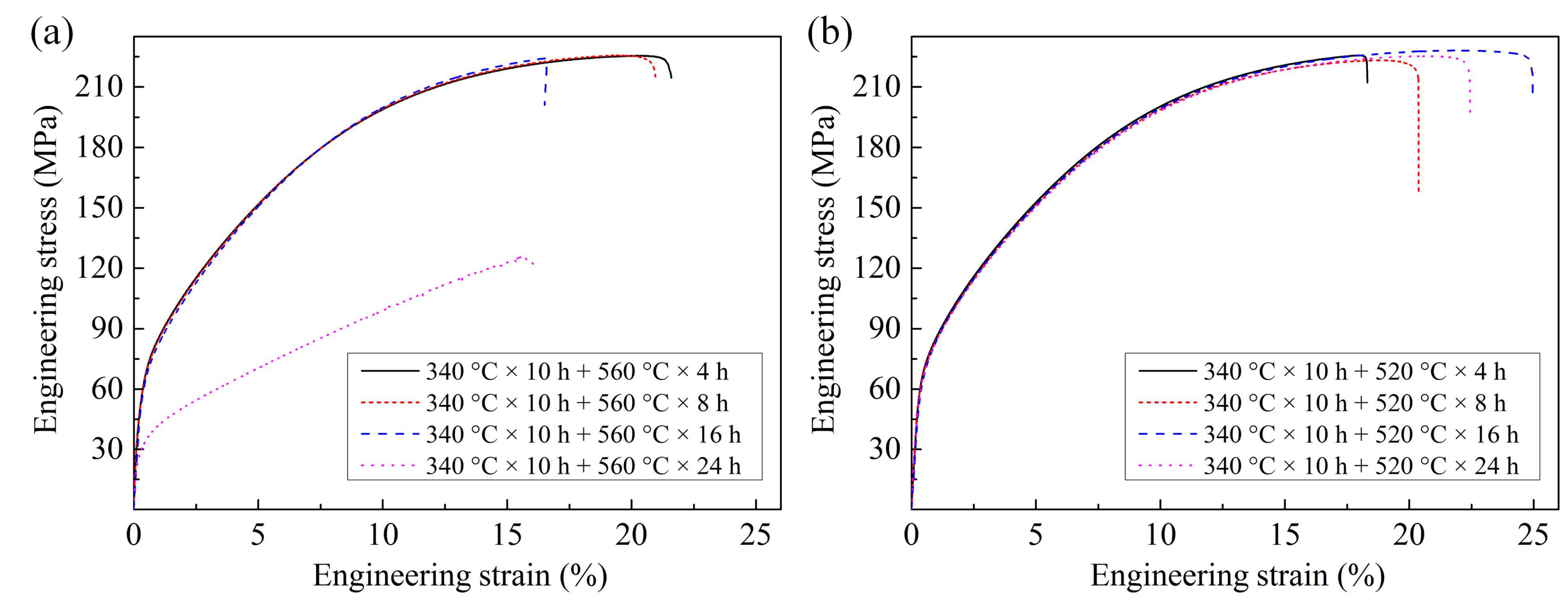
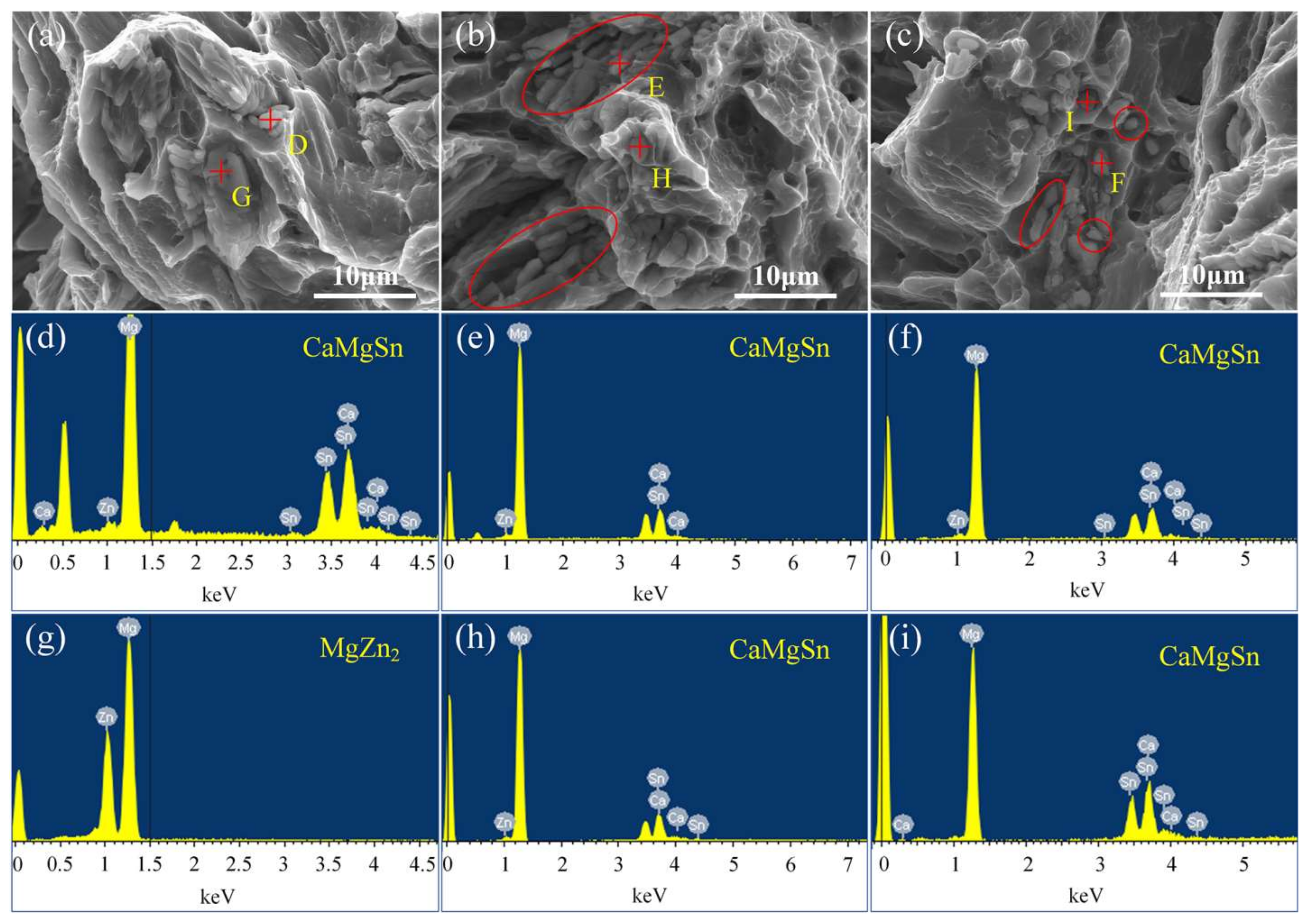
| Analyzed Element | Actual Composition (wt %) | |||
|---|---|---|---|---|
| Center | 1/2 Radius | Near the Surface | Average | |
| Zn | 3.32 | 3.37 | 3.39 | 3.36 |
| Sn | 1.06 | 1.05 | 1.08 | 1.06 |
| Mn | 0.32 | 0.34 | 0.34 | 0.33 |
| Ca | 0.26 | 0.27 | 0.28 | 0.27 |
| Mg | Bal. | Bal. | Bal. | Bal. |
| Point | Mg | Zn | Sn | Ca | ||||
|---|---|---|---|---|---|---|---|---|
| wt % | at % | wt % | at % | wt % | at % | wt % | at % | |
| D | 64.35 | 85.76 | 2.99 | 1.48 | 25.47 | 6.95 | 7.18 | 5.81 |
| E | 76.94 | 91.45 | 4.05 | 1.79 | 14.56 | 3.54 | 4.46 | 3.21 |
| F | 43.94 | 67.82 | 56.06 | 32.18 | - | - | - | - |
| G | 99.13 | 99.68 | 0.87 | 0.32 | - | - | - | - |
| Areas | YS (MPa) | UTS (MPa) | EL (%) |
|---|---|---|---|
| Along the radial direction | |||
| Center | 81.3 ± 2.0 | 210.0 ± 2.0 | 14.0 ± 0.4 |
| 1/2 radius | 82.0 ± 1.1 | 207.0 ± 0.9 | 15.0 ± 0.7 |
| Near the surface | 75.0 ± 0.9 | 199.0 ± 1.3 | 13.5 ± 1.1 |
| Along the axial direction | |||
| Center | 82.5 ± 0.5 | 212.0 ± 2.4 | 14.9 ± 0.9 |
| 1/2 radius | 84.5 ± 1.2 | 210.0 ± 0.9 | 16.0 ± 0.8 |
| Near the surface | 76.0 ± 1.1 | 202.0 ± 1.5 | 14.2 ± 0.7 |
| Homogenization Conditions | YS (MPa) | UTS (MPa) | EL (%) |
|---|---|---|---|
| One-step homogenization | |||
| 460 °C × 16 h | 78.0 ± 2.5 | 225.0 ± 0.5 | 17.0 ± 0.4 |
| 500 °C × 16 h | 72.0 ± 0.8 | 223.0 ± 1.6 | 17.5 ± 0.8 |
| 540 °C × 16 h | 71.0 ± 0.5 | 230.0 ± 1.0 | 20.0 ± 0.5 |
| Two-step homogenization | |||
| 340 °C × 10 h + 560 °C × 4 h | 69.0 ± 2.8 | 225.0 ± 0.7 | 21.5 ± 0.4 |
| 340 °C × 10 h + 560 °C × 8 h | 67.0 ± 0.5 | 226.0 ± 1.2 | 21.0 ± 1.3 |
| 340 °C × 10 h + 560 °C × 16 h | 68.0 ± 0.7 | 224.0 ± 0.8 | 16.3 ± 1.1 |
| 340 °C × 10 h + 560 °C × 24 h | 32.0 ± 4.2 | 125.0 ± 3.8 | 15.3 ± 2.1 |
| 340 °C × 10 h + 520 °C × 4 h | 72.0 ± 1.2 | 226.0 ± 0.9 | 18.5 ± 0.7 |
| 340 °C × 10 h + 520 °C × 8 h | 70.0 ± 0.9 | 223.0 ± 1.5 | 20.5 ± 0.7 |
| 340 °C × 10 h + 520 °C × 16 h | 67.0 ± 0.7 | 228.0 ± 0.7 | 25.0 ± 0.5 |
| 340 °C × 10 h + 520 °C × 24 h | 66.0 ± 1.1 | 225.0 ± 1.4 | 22.5 ± 0.9 |
© 2018 by the authors. Licensee MDPI, Basel, Switzerland. This article is an open access article distributed under the terms and conditions of the Creative Commons Attribution (CC BY) license (http://creativecommons.org/licenses/by/4.0/).
Share and Cite
Lu, X.; Zhao, G.; Zhou, J.; Zhang, C.; Yu, J. Microstructure and Mechanical Properties of the As-Cast and As-Homogenized Mg-Zn-Sn-Mn-Ca Alloy Fabricated by Semicontinuous Casting. Materials 2018, 11, 703. https://doi.org/10.3390/ma11050703
Lu X, Zhao G, Zhou J, Zhang C, Yu J. Microstructure and Mechanical Properties of the As-Cast and As-Homogenized Mg-Zn-Sn-Mn-Ca Alloy Fabricated by Semicontinuous Casting. Materials. 2018; 11(5):703. https://doi.org/10.3390/ma11050703
Chicago/Turabian StyleLu, Xing, Guoqun Zhao, Jixue Zhou, Cunsheng Zhang, and Junquan Yu. 2018. "Microstructure and Mechanical Properties of the As-Cast and As-Homogenized Mg-Zn-Sn-Mn-Ca Alloy Fabricated by Semicontinuous Casting" Materials 11, no. 5: 703. https://doi.org/10.3390/ma11050703



